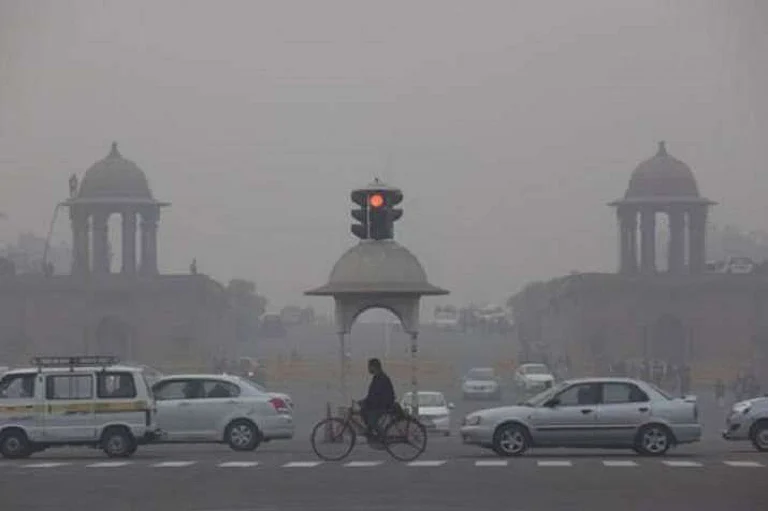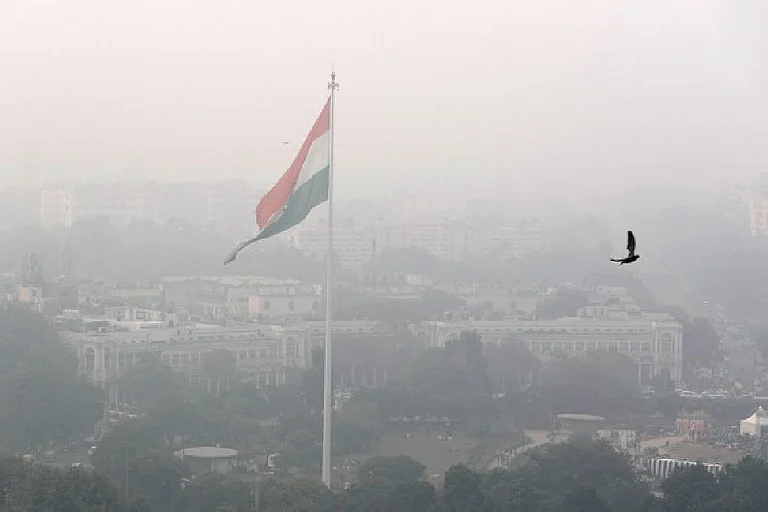Air Quality Index (AQI) at 7 am reached 455, according to AQI.in.
This level is comparable to smoking nearly 11 cigarettes a day.
Delhi’s air quality has fallen just weeks after the government’s cloud-seeding experiment failed to produce artificial rain or reduce particulate levels.
Delhi’s Air Turns Into ‘Gas Chamber’ As AQI Breaches 450; Supreme Court Grants CAQM Free Hand To Act
Breathing in Delhi today is the equivalent of smoking 11 cigarettes.
On Friday, November 21, 2025, Delhi woke up choking again, breathing toxic air as pollution levels climbed over 700 and averaged 515 across the city in the early hours.
A thick grey haze settled over the city as the Air Quality Index (AQI) at 7 am reached 455, according to AQI.in, a level comparable to smoking nearly 11 cigarettes a day. The spike came just weeks after a cloud-seeding experiment at significant public expense failed to produce artificial rain or reduce particulate levels.
The city’s pollution readings fluctuated across monitoring systems. At 5:30 a.m., the Delhi Early Warning System recorded an AQI of 373 and 433 at 5 am. Officials said the variation stems from differing methodologies, the number and location of monitoring stations, and the parameters each body measures.
Severe To Hazardous Air Quality
With pollution in the “severe” range, the Commission for Air Quality Management (CAQM) has started Stage III of the Graded Response Action Plan (GRAP-III). This stage begins when the AQI is at or expected to exceed 401. Measures include stopping non-essential construction, increasing machine road cleaning, and more water spraying to control dust in Delhi and nearby cities.
NCR cities such as Faridabad reported AQIs of 570 at 7:34 am, while Ghaziabad's AQI was 543. Noida and Greater Noida recorded air quality at toxic levels, with readings of 514 and 458, respectively.
The capital’s residents have been advised to avoid going outdoors unless necessary and to wear N95 masks if stepping out. Authorities also urged people to refrain from outdoor exercise and use home and car air purifiers. Anyone experiencing respiratory distress was advised to seek immediate medical attention.
Particulate concentrations remained far above safe limits. PM2.5 levels were around 280 μg/m³, and PM10 levels hovered near 370 μg/m³, compared with the World Health Organisation’s 24-hour safe limits of 15 μg/m³ for PM2.5 and 45 μg/m³ for PM10.
Supreme Court’s Guidelines: Proactive Measures, Staggered Work Timings
As citizens of the city held protests, the Supreme Court on Wednesday (November 19, 2025) granted the CAQM a free hand to take “any proactive measure” to curb pollution in Delhi-NCR. The apex court’s direction came as the statutory body proposed implementing several GRAP-IV measures—traditionally reserved for even more severe air episodes—within the current GRAP-III stage. These include work-from-home advisories and 50 per cent office attendance to reduce vehicular emissions.
“Any proactive measure of CAQM to reduce air pollution is always welcome,” Chief Justice of India B.R. Gavai observed, while emphasising that the Commission must consult stakeholders before issuing new directives. The Court was responding to a comprehensive note submitted by the CAQM outlining short- and long-term actions.
Amicus curiae Aparajita Singh discussed a suggestion to remove certain older vehicles from protection under a Supreme Court order issued on August 12, 2025. The SC, then, had ordered that no action be taken against owners of diesel vehicles older than 10 years and petrol vehicles older than 15 years.
The Chief Justice reiterated that the Commission has the power to take the necessary steps.
Among additional proposals, the CAQM recommended introducing staggered office timings earlier, at GRAP-II rather than GRAP-III, and expanding public transport capacity across stages. It also sought faster notification of vehicle-aggregator policies and the creation of an NCR-wide portal to monitor them. The court asked if school sports events during November and December could be postponed, with Singh warning that exposing children to current air conditions was akin to placing them in a “gas chamber.”
The top court then said that the CAQM must issue appropriate directions to the concerned states.
Long-term proposals outlined by the CAQM include revising electric-vehicle policies, imposing higher environmental protection charges on diesel vehicles of 2000 cc and above (currently taxed at one per cent), prohibiting new coal-based thermal power plants within 300 km of Delhi, fast-tracking legacy-waste clearance, strengthening construction-waste management, and redeveloping roads with green shoulders.
The Supreme Court ordered officials to fill open positions in pollution boards and ensure that daily-wage workers who lost their jobs due to GRAP-III rules receive basic financial support. The Chief Justice noted that air pollution requires the court's ongoing attention, and said the case will be monitored regularly, with the next hearing set for December 10.

